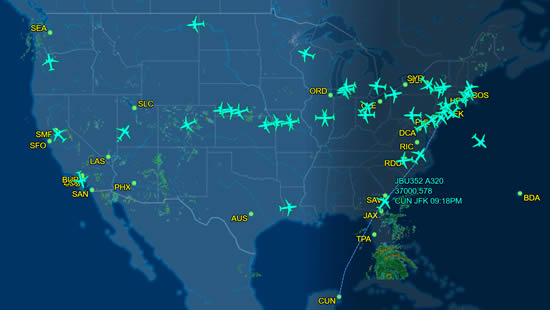 |
How to fly private without being tracked |
Nick Copley, president of SherpaReport, does the heavy lifting when it comes to defining what you need to know about access to business aviation, whether full ownership, fractional, jet cards or charters. This week he explores how to access business aircraft without being tracked.
Whether it’s because you’re a celebrity or because you don’t want the corporate jet’s flightpath to give hedge funds and investment managers an early signal of a large corporate deal, merger or acquisition, many private jet owners seek privacy and therefore do not want to be tracked.
All aircraft flights are tracked - and it is essential that they are - to ensure flights are safe and efficient. Tracking allows Air Traffic Control (ATC) to see and manage flights, other aircraft to see each other, and ground crews to prepare for arrivals and departures ensuring the safe and smooth operation of the whole air transport industry.
However, many tracking platforms exist that are accessible to the public. In the US, as of January 2020, the FAA has required that all aircraft operating over the country use the Automatic Dependent Surveillance-Broadcast (ADS-B) tracking technology platform. This is the one student Jack Sweeney used to track Elon Musk’s Gulfstream. There are also numerous other organizations that provide varying forms of public tracking services as well, including FlightAware, Radarbox and Planefinder. Note that these services will block aircraft from the public feed if requested.

There are numerous organizations that provide varying forms of public tracking services, including FlightAware, Radarbox and Planefinder | Image shown courtesy FlightAware.
So, what are the options for anyone who prefers their flightpath remain private when flying in a business jet?
To address privacy concerns, the FAA has initiated the Privacy ICAO aircraft address (PIA) program, in which owners can request an alternate, temporary ICAO aircraft address which won’t be shown in the publicly available Civil Aviation Registry. The FAA also has the Limiting Aircraft Data Displayed (LADD) program, allowing owners to choose to make it available only for FAA use.
As with car registration, tail-numbers are regularly associated with a company or personal name, yet there are ways to maintain privacy, reduce visibility, and optimize the benefits of private aviation. Fractional ownership, jet card memberships or charters - with aircraft tail numbers all owned by a third party - are good options. This is what the world’s richest man, Bernard Arnault, Chairman and CEO of LVMH Moët Hennessy - Louis Vuitton, the world's largest luxury goods company, did. He recently sold his private jet, an ultra-long-range Bombardier Global 7500, largely driven by privacy concerns. Instead, he is now chartering private aircraft.
Another option is fractional ownership. Companies such as NetJets, Flexjet, PlaneSense and Airshare offer fractional ownership or lease structures for private jets. The percentage of aircraft owned will normally equate to annual flying hours. For example, 6.25%, or a one sixteenth fractional share delivers about 50 flying hours per year. This increasingly popular option gives access to airframes large and small, from turboprop to large-cabin, from mid- to long-range executive jets.
The operator (NetJets, Flexjet, etc.) has its name in the aircraft registry, and flight tracking would show, for instance, a NetJets flight, greatly reducing the chance of passenger identification. Actually, the way the fleet is managed and or operated means that an owner may never fly on their owned fraction but could fly on any similar aircraft in the fleet. In addition, the success of these operators depends on discrete service levels and privacy protocols, for which many are renowned.
A third option to avoid tracking is a jet card or membership. The economics of cards and memberships work differently to charter, with cards offering fixed hourly rates, as opposed to the market-driven variable rates of charter. In the same way that the aircraft is registered to a fractional fleet operator, the charter operators register the aircraft, which ensures holders of jet cards and jet memberships cannot be easily identified by looking at aircraft flight tracking data.
Private jet ownership offers many advantages, but if privacy is important to you and/or your business, perhaps other business aviation access options are a better fit. Learn more about the pros and cons of all options to access business aviation at www.sherpareport.com





